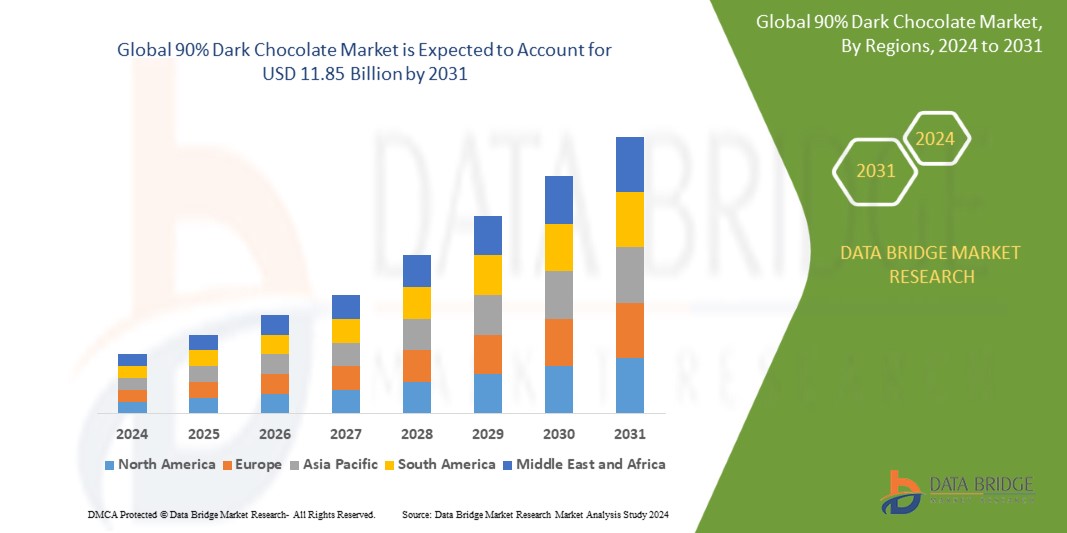Global 90% Dark Chocolate Market
市场规模(十亿美元)
CAGR :
% 
| 2024 –2031 | |
| USD 8.40 Billion | |
| USD 11.85 Billion | |
|
|
|
全球 90% 黑巧克力市场细分、产品类型(有机和传统)、包装类型(棒薯片、块和块)、分销渠道(超市/大卖场、专卖店、在线零售和便利店)、最终用户(零售消费者和食品服务行业)、形式(固体和液体)、口味(薄荷、橙子、海盐和其他口味)、消费者年龄组(儿童、成人和老年人)– 行业趋势和预测到 2031 年
90% 黑巧克力市场分析
全球 90% 黑巧克力市场正在经历显著增长,这得益于消费者对黑巧克力相关健康益处的认识不断提高,例如改善心脏健康和抗氧化特性。2023 年,该市场价值约为 84 亿美元,预计未来八年复合年增长率 (CAGR) 将达到 4.4%。人们越来越倾向于健康饮食习惯,对优质高可可含量巧克力的需求正在推动这一市场向前发展。然而,市场也面临着挑战,包括可可等原材料成本高昂,以及受气候变化和供应链中断影响的价格波动。此外,来自替代甜味剂和低可可含量巧克力的竞争可能会阻碍增长。各公司正专注于产品创新,例如有机和可持续采购的巧克力,以满足注重健康的消费者不断变化的口味。总体而言,市场反映出向优质健康导向产品的转变,与消费者行为中更广泛的健康趋势相一致。
90% 黑巧克力市场规模
2023 年全球 90% 黑巧克力市场规模价值 84 亿美元,预计到 2031 年将达到 118.5 亿美元,2024 年至 2031 年预测期内的复合年增长率为 4.4%。除了对市场价值、增长率、细分、地理覆盖范围和主要参与者等市场情景的见解外,Data Bridge Market Research 策划的市场报告还包括深入的专家分析、定价分析、品牌份额分析、消费者调查、人口分析、供应链分析、价值链分析、原材料/消耗品概述、供应商选择标准、PESTLE 分析、波特分析和监管框架。
90% 黑巧克力市场趋势
“提高对道德采购和可持续性的认识”
对符合道德采购和可持续产品的需求正在上升,这一趋势延伸到了巧克力行业。许多消费者现在更加意识到购买产品对环境和社会的影响,从而促使他们转向优先考虑可持续实践的品牌。这包括从从事公平贸易实践的农场采购可可,以确保农民获得公平的劳动报酬。能够有效传达其对道德采购和可持续性承诺的品牌可能会吸引重视这些原则的忠实客户群。此外,随着气候变化对可可生产的影响越来越大,投资于可持续农业实践的公司也可以为长期生存做出贡献,同时吸引具有环保意识的消费者。对道德采购和可持续性的高度关注推动了对高品质黑巧克力(包括 90% 品种)的需求。
报告范围和市场细分
|
属性 |
90% 黑巧克力关键市场洞察 |
|
分割 |
|
|
覆盖国家 |
美国、加拿大、墨西哥、德国、法国、英国、荷兰、瑞士、比利时、俄罗斯、意大利、西班牙、土耳其、欧洲其他地区、中国、日本、印度、韩国、新加坡、马来西亚、澳大利亚、泰国、印度尼西亚、菲律宾、亚太其他地区、沙特阿拉伯、阿联酋、南非、埃及、以色列、中东和非洲其他地区、巴西、阿根廷、南美洲其他地区 |
|
主要市场参与者 |
Cemoi Chocolatier(法国)、Republica del Cacao(厄瓜多尔)、雀巢公司(瑞士)、玛氏公司(美国)、Guittard Chocolate Co.(美国)、Ghirardelli Chocolate Co.(美国)、Valrhona Inc.(法国)、Barry Callebaut AG(瑞士)、Alpezzi Chocolate(墨西哥)、Kerry Group Plc(爱尔兰)、Olam International Ltd.(新加坡)、Tcho Ventures Inc.(美国)、好时公司(美国)、嘉吉公司(美国)、Blommer Chocolate Company(美国)、Puratos(比利时)和费列罗国际公司(意大利) |
|
市场机会 |
|
|
增值数据信息集 |
除了对市场价值、增长率、细分、地理覆盖范围和主要参与者等市场情景的见解之外,Data Bridge Market Research 策划的市场报告还包括深入的专家分析、定价分析、品牌份额分析、消费者调查、人口分析、供应链分析、价值链分析、原材料/消耗品概述、供应商选择标准、PESTLE 分析、波特分析和监管框架。 |
90% 黑巧克力 市场定义
90% 黑巧克力是一种由 90% 可可固体(包括可可液和可可脂)和少量糖制成的巧克力。它具有浓郁、浓郁的可可味,与牛奶或浅色黑巧克力相比,甜度较低。
90% 黑巧克力市场动态
驱动程序
- 黑巧克力的健康益处
黑巧克力,尤其是可可含量为 90% 或更高的品种,因其众多健康益处而越来越受到认可。它富含抗氧化剂、黄酮类化合物和必需矿物质,与各种健康益处有关,例如改善心脏健康、降低血压和增强大脑功能。高可可含量有助于其营养成分,研究表明黑巧克力可能有助于改善胰岛素敏感性并降低患慢性病的风险。此外,黑巧克力中的多酚被认为可以通过改善血液流动和降低胆固醇水平来促进心血管健康。2022 年 7 月,根据 Healthline Media LLC 发表的一篇文章,黑巧克力,尤其是可可含量高的黑巧克力,具有多种健康益处。它含有重要的营养成分,如纤维、铁、镁和抗氧化剂。研究表明血流改善,血压降低。研究表明 LDL 氧化和心脏病风险降低。证据表明,它有可能保护皮肤免受阳光伤害并增强大脑功能。随着消费者越来越注重健康,寻求具有健康益处的功能性食品,对可可含量高的巧克力的需求可能会增加。这种日益增长的意识和对优质健康产品的投资意愿推动了 90% 黑巧克力的市场。
- 美食和手工巧克力需求不断增长
美食和手工食品的日益流行正在重塑巧克力市场的消费者偏好。美食黑巧克力,尤其是可可含量高的黑巧克力,不仅被视为糖果,而且被视为可以品尝和享受的优质食品。消费者越来越多地寻求巧克力中独特的风味、质地和来源,这导致小批量手工巧克力品牌的受欢迎程度激增,这些品牌生产的 90% 都是黑巧克力。这一细分市场迎合了那些追求质量和复杂性而非大规模生产的替代品的挑剔口味。此外,手工巧克力制造商通常强调可持续和合乎道德的可可采购,这引起了有道德意识的消费者的共鸣。这种向美食产品的转变为高可可含量巧克力市场提供了强大的增长动力。
- 提高对道德采购和可持续性的认识
对符合道德采购和可持续产品的需求正在上升,这一趋势延伸到了巧克力行业。许多消费者现在更加意识到购买产品对环境和社会的影响,促使他们转向优先考虑可持续实践的品牌。这包括从从事公平贸易实践的农场采购可可,以确保农民获得公平的劳动报酬。能够有效传达其对道德采购和可持续性承诺的品牌很可能吸引重视这些原则的忠实客户群。此外,随着气候变化对可可生产的影响越来越大,投资于可持续农业实践的公司也可以为长期生存做出贡献,同时吸引具有环保意识的消费者。对道德采购和可持续性的高度关注推动了对高品质黑巧克力(包括 90% 品种)的需求。
机会
- 新兴市场扩张
新兴市场中产阶级的不断壮大为全球黑巧克力市场带来了巨大的机遇,尤其是可可含量较高的品种,如 90% 的黑巧克力。随着可支配收入的增加,这些地区的消费者越来越愿意花钱购买高端产品,包括美食和巧克力。在印度、巴西和中国等国家,消费者的偏好明显转向更健康、更精致的食品选择。这为希望推出符合当地口味的高品质黑巧克力产品的品牌创造了巨大的市场潜力。此外,随着电子商务平台的普及,品牌可以更有效地接触这些消费者,扩大其市场占有率并推动销售增长。
- 创新产品开发和口味
黑巧克力市场已经成熟,可以进行创新,特别是在产品开发和风味方面。制造商可以尝试独特的成分,例如异国风味的香料、水果或坚果,以创造吸引冒险消费者的差异化产品。此外,加入超级食品或益生菌等功能性成分可以增强黑巧克力的健康益处,进一步吸引注重健康的消费者。限量版口味和季节性产品也可以引起轰动并推动销售。通过拥抱创新并紧跟消费者趋势,品牌可以利用对独特和高品质黑巧克力产品(包括可可含量高的黑巧克力产品)日益增长的需求。
限制/挑战
- 可可价格高企和供应链问题
全球可可市场面临多重挑战,包括价格波动和供应链中断。气候变化、可可树老化以及科特迪瓦和加纳等主要可可生产国的政治不稳定等因素都可能导致可可价格波动。价格上涨会严重影响巧克力制造商的盈利能力,尤其是那些生产高可可含量巧克力的制造商,因为他们依赖优质可可豆。此外,供应链问题因 COVID-19 疫情等全球事件而加剧,可能导致原材料采购延迟和成本增加。2022 年 7 月,由于对西非供应紧张的担忧,可可期货交易价格约为每吨 7,800 美元,达到自 9 月初以来的最高水平。科特迪瓦农民在 10 月 1 日至 9 月 22 日期间运送了 175.4 万吨可可,比上年下降了 24.5%。 ICE 监测的美国港口可可库存连续 15 个月下降,达到 2,190,684 袋的 15 年低点。国际可可组织预测,2023-24 季全球产量缺口为 462,000 吨。有利的天气条件使人们对即将到来的 10 月至 2025 年 3 月的作物季节持乐观态度。这些挑战可能使品牌难以保持一致的产品质量和定价,从而可能阻碍市场增长。
- 消费者的认知和口味偏好
虽然黑巧克力的健康益处已得到充分证实,但消费者口味偏好方面仍存在挑战。许多消费者仍然将巧克力与甜味联系在一起,可能会发现可可含量高的品种(如 90% 黑巧克力)对他们的味蕾来说太苦或太浓烈。这可能会限制这些产品的潜在客户群,因为有些人可能不愿尝试或采用这种口味浓烈的产品。为了克服这一挑战,品牌必须投资于消费者教育和营销工作,突出黑巧克力的细微风味和健康益处。此外,提供一系列可可百分比或混合选项可以帮助消费者轻松接受更高可可含量的产品,并扩大 90% 黑巧克力的市场覆盖范围。
本市场报告详细介绍了最新发展、贸易法规、进出口分析、生产分析、价值链优化、市场份额、国内和本地市场参与者的影响,分析了新兴收入领域的机会、市场法规的变化、战略市场增长分析、市场规模、类别市场增长、应用领域和主导地位、产品批准、产品发布、地域扩展、市场技术创新。如需获取更多市场信息,请联系 Data Bridge Market Research 获取分析师简报,我们的团队将帮助您做出明智的市场决策,实现市场增长。
原材料短缺和运输延误的影响和当前市场状况
Data Bridge Market Research 提供高水平的市场分析,并通过考虑原材料短缺和运输延误的影响和当前市场环境来提供信息。这意味着评估战略可能性、制定有效的行动计划并协助企业做出重要决策。
除了标准报告外,我们还提供从预测的运输延迟、按区域划分的分销商映射、商品分析、生产分析、价格映射趋势、采购、类别绩效分析、供应链风险管理解决方案、高级基准测试等角度对采购层面的深入分析,以及其他采购和战略支持服务。
经济放缓对产品定价和供应的预期影响
当经济活动放缓时,行业开始受到影响。DBMR 提供的市场洞察报告和情报服务考虑了经济衰退对产品定价和可获得性的预测影响。借助这些,我们的客户通常可以领先竞争对手一步,预测他们的销售额和收入,并估算他们的盈亏支出。
全球 90% 黑巧克力市场范围
市场根据产品类型、包装类型、分销渠道、最终用户、形式和消费者年龄组进行细分。这些细分市场之间的增长将帮助您分析行业中增长微弱的细分市场,并为用户提供有价值的市场概览和市场洞察,帮助他们做出战略决策,确定核心市场应用。
产品类型
- 有机的
- 传统的
包装类型
- 酒吧
- 芯片
- 咬
- 区块
终端用户
- 零售消费者
- 食品服务业
形式
- 坚硬的
- 液体
消费者年龄层
- 孩子们
- 成年人
- 老年人
分销渠道
- 超市/大卖场
- 专卖店
- 网上零售
- 便利店
全球 90% 黑巧克力市场区域分析
对市场进行分析,并按国家、产品类型、包装类型、分销渠道、最终用户、形式和消费者年龄组提供市场规模洞察和趋势。
市场覆盖的国家包括美国、加拿大、墨西哥、德国、法国、英国、荷兰、瑞士、比利时、俄罗斯、意大利、西班牙、土耳其、欧洲其他地区、中国、日本、印度、韩国、新加坡、马来西亚、澳大利亚、泰国、印度尼西亚、菲律宾、亚太其他地区、沙特阿拉伯、阿联酋、南非、埃及、以色列、中东和非洲其他地区、巴西、阿根廷以及南美洲其他地区。
由于欧洲拥有悠久的巧克力文化和对优质产品的高需求,预计欧洲将主导市场。欧洲强劲的市场得益于成熟的巧克力消费模式和对高品质手工巧克力的偏好
亚太地区预计将成为增长最快的地区,因为该地区的可支配收入正在增加,消费者对黑巧克力的健康益处的认识也在不断提高。亚太地区的增长得益于西方食品趋势和消费者健康意识的转变,消费者现在更倾向于购买具有健康益处的巧克力产品。
报告的国家部分还提供了影响单个市场因素和国内市场监管变化,这些因素和变化会影响市场的当前和未来趋势。下游和上游价值链分析、技术趋势和波特五力分析、案例研究等数据点是用于预测单个国家市场情景的一些指标。此外,在提供国家数据的预测分析时,还考虑了全球品牌的存在和可用性以及它们因来自本地和国内品牌的激烈或稀缺竞争而面临的挑战、国内关税和贸易路线的影响。
全球 90% 黑巧克力市场份额
市场竞争格局提供了竞争对手的详细信息。详细信息包括公司概况、公司财务状况、产生的收入、市场潜力、研发投资、新市场计划、全球影响力、生产基地和设施、生产能力、公司优势和劣势、产品发布、产品宽度和广度、应用主导地位。以上提供的数据点仅与公司对市场的关注有关。
90% 在市场上运营的黑巧克力市场领导者是:
- Cemoi Chocolatier(法国)
- 可可共和国 (厄瓜多尔)
- 雀巢公司(瑞士)
- 玛氏公司(美国)
- Guittard 巧克力公司(美国)
- 吉拉德利巧克力公司(美国)
- Valrhona Inc.(法国)
- 百乐嘉利宝股份公司(瑞士)
- 阿尔佩齐巧克力
- 凯里集团有限公司 (爱尔兰)
- Olam International Ltd.(新加坡)
- Tcho Ventures Inc.(美国)
- 好时公司 (美国)
- 嘉吉公司(美国)
- 布洛默巧克力公司(美国)
- 普拉托斯
- 费列罗国际有限公司(意大利)
90% 黑巧克力市场的最新发展
- 2021 年 4 月,SkinnyDipped 推出了低糖巧克力棒和花生酱杯。新产品的含糖量比领先品牌低 79%。成分中不含甜菊糖或糖醇。这些产品被宣传为比全糖替代品更美味。该品牌旨在创造更适合您的零食选择
SKU-
Get online access to the report on the World's First Market Intelligence Cloud
- Interactive Data Analysis Dashboard
- Company Analysis Dashboard for high growth potential opportunities
- Research Analyst Access for customization & queries
- Competitor Analysis with Interactive dashboard
- Latest News, Updates & Trend analysis
- Harness the Power of Benchmark Analysis for Comprehensive Competitor Tracking
研究方法
Data collection and base year analysis are done using data collection modules with large sample sizes. The stage includes obtaining market information or related data through various sources and strategies. It includes examining and planning all the data acquired from the past in advance. It likewise envelops the examination of information inconsistencies seen across different information sources. The market data is analysed and estimated using market statistical and coherent models. Also, market share analysis and key trend analysis are the major success factors in the market report. To know more, please request an analyst call or drop down your inquiry.
The key research methodology used by DBMR research team is data triangulation which involves data mining, analysis of the impact of data variables on the market and primary (industry expert) validation. Data models include Vendor Positioning Grid, Market Time Line Analysis, Market Overview and Guide, Company Positioning Grid, Patent Analysis, Pricing Analysis, Company Market Share Analysis, Standards of Measurement, Global versus Regional and Vendor Share Analysis. To know more about the research methodology, drop in an inquiry to speak to our industry experts.
可定制
Data Bridge Market Research is a leader in advanced formative research. We take pride in servicing our existing and new customers with data and analysis that match and suits their goal. The report can be customized to include price trend analysis of target brands understanding the market for additional countries (ask for the list of countries), clinical trial results data, literature review, refurbished market and product base analysis. Market analysis of target competitors can be analyzed from technology-based analysis to market portfolio strategies. We can add as many competitors that you require data about in the format and data style you are looking for. Our team of analysts can also provide you data in crude raw excel files pivot tables (Fact book) or can assist you in creating presentations from the data sets available in the report.





